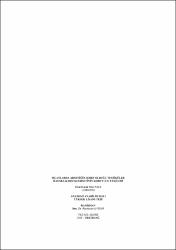| dc.contributor.author | Baltacı, Bilal Burak | |
| dc.date.accessioned | 2017-05-26T08:28:02Z | |
| dc.date.available | 2017-05-26T08:28:02Z | |
| dc.date.issued | 2015 | |
| dc.identifier.uri | https://hdl.handle.net/20.500.11776/1233 | |
| dc.description.abstract | Arsenik hava, su ve toprakta bulunan toksik bir metaldir. Dünya genelinde milyonlarca insanı etkileyen arsenik özellikle erkek üreme sistemi üzerine sitotoksik etki göstermektedir. Çalışmamızda arsenik maruziyetiyle testislerde oluşan değişiklikler üzerine kuersetinin etkisi araştırıldı. Çalışmamızda 27 adet Sprague-Dawley cinsi erkek sıçan üç gruba ayrıldı. Kontrol grubu (10 ml/kg/gün serum fizyolojik, intragastrik), Arsenik grubu (10 mg/kg/gün sodyum arsenit, intragastrik), Arsenik + Kuersetin grubu (10 mg/kg/gün sodyum arsenit, intragastrik ve 50 mg/kg/gün kuersetin, intragastrik) olarak oluşturuldu. 15 gün boyunca devam eden deneyin sonunda sıçanlar tartılarak sakrifiye edildi. Testis dokuları alınarak tartıldı. Histopatolojik inceleme için testis kesitleri hematoksilen-eozin (H-E) ile boyandı. Apoptozisin belirlenmesi için TUNEL (Terminal Deoxynucleotidyl Transferase Mediated dUTP Nick End Labeling) yöntemi kullanıldı. Hücre proliferasyonunun değerlendirilmesi için PCNA (proliferating cell nuclear antigen) yöntemi kullanıldı. Biyokimyasal olarak süperoksit dismutaz (SOD), katalaz (CAT) ve glutatyon peroksidaz (GSH-Px) enzim aktiviteleri, malondialdehit (MDA) düzeyleri spektrofotometrik olarak belirlendi. Ayrıca serum total testosteron seviyeleri tespit edildi. Testislerdeki arsenik miktarının analizi İndüktif Eşleşmiş Plazma / Optik Emisyon Spektrometresi (ICP-OES) ile yapıldı. Verilerin istatistiksel analizi ve gruplar arası karşılaştırmalar yapıldı. Arsenik maruziyeti sonucunda, sıçanların vücut ağırlık kazanımı ve testis ağırlıkları açısından kontrol grubu ile arsenik grubu arasında bir farkın olmadığı, arsenik grubu sıçan testislerinde histopatolojik olarak seminifer tübül yapısında bozulma ve tübül çaplarında azalma, spermatogenik seriye ait hücre sayısında azalma, seminifer tübüllerin duvarında TUNEL pozitif apoptotik hücre sayısında artış, PCNA pozitif hücre sayısında azalma gözlendi. Kuersetin uygulamasının vücut ağırlığı, vücut ağırlık kazancı ve testis ağırlığı açısından anlamlı bir değişikliğe neden olmadığı görüldü. Kuersetin tedavisi sonucunda testisteki yapısal bozulmaların hafiflediği, TUNEL pozitif hücre sayısının azaldığı, PCNA pozitif hücre sayısının arttığı tespit edildi. Biyokimyasal olarak arsenik maruziyetinin testis dokusunda SOD, CAT ve GSH-Px enzim aktivitelerinde azalmaya, MDA düzeyinde ise artmaya neden olduğu saptandı. Arsenik grubunda serum total testosteron düzeyinde anlamlı bir değişim olmadığı bulundu. Kuersetin uygulamasıyla SOD, CAT ve GSH-Px aktivitelerinde artış, MDA düzeyinde ise azalma tespit edildi. Kuersetinin serum total testosteron düzeyinde anlamlı bir fark oluşturmadığı bulundu. Arsenik miktarlarının arsenik grubunda kontrol grubuna göre arttığı, kuersetin grubu ile arsenik grubu arasında arsenik miktarları açısından istatistiksel olarak anlamlı bir farkın olmadığı görüldü. Sonuç olarak arseniğin sıçan testislerinde neden olduğu histopatolojik değişiklikler, apoptozis, oksidatif stres ve lipid peroksidasyonunu kuersetinin antiapoptotik ve antioksidan etkileri ile azaltarak koruyucu etki gösterdiği bulundu. | en_US |
| dc.description.abstract | Arsenic is a toxic metal found in water, air and soil. Arsenic affects millions of people worldwide, especially cytotoxic effects on the male reproductive system. In this study, protective effects of quercetin against arsenic-induced testicular damage in rats. In this study, 27 Sprague-Dawley male rats were divided into three groups. Control group (10 ml/kg/day SF, intragastric), Arsenic group (10 mg/kg/day sodium arsenite, intragastric), arsenic + quercetin group (10 mg/kg/day sodium arsenite, intragastric + 50 mg/kg/day quercetin, intragastric). For 15 days at the end of the ongoing experiments, rats were sacrificed. Testis tissues were taken and stained with hematoxylin and eosin (H-E) for histopathological analysis. Apoptotic cells were studied by using TUNEL (Terminal deoxynucleotidyl Transferase Biotin-dUTP Nick End Labeling) assay. Cell proliferation was studied by PCNA (proliferating cell nuclear antigen) method. For biochemical analysis, the activities of antioxidant enzymes such as superoxide dismutase (SOD), catalase (CAT), and glutathione peroxidase (GSH-Px) as well as malondialdehyde (MDA) levels were measured spectrophotometrically. In addition, total serum testosterone levels were determined. The amount of arsenic in the testes was analyzed by Inductively Coupled Plasma / Optical Emission Spectrometry (ICP-OES). Statistical analyses of the numeric data were performed and the comparisons among groups were calculated. As a result of exposure to arsenic in rats, there were no statistically significant difference body weights, body weight gain and testes weights between arsenic group and control group. It was observed that decreased the number of germ cells and PCNA - positive cells, reduced degeneration of seminiferous tubulus, as well as increased the number of Tunel - positive apoptotic cells in the walls of the seminiferous tubules in the arsenic group by histopathological methods. After quercetin treatment, there were no significant difference body weights, body weight gain and testes weights. We showed that structural deterioration in testes was ameliorated, decreased the number of Tunel-positive apoptotic cells, increased the number of PCNA-positive cells. Arsenic exposure in testes tissues caused decrease SOD, CAT and GSH-Px activities an increase in the levels of MDA was detected by biochemical analysis. Total serum testosterone levels showed no change in the arsenic group. SOD, CAT and GSH-Px activities increased and a decrease in levels of MDA were determined after quercetin administration. Total serum testosterone levels found no significant difference in arsenic + quercetin group. Arsenic group had higher amunt of arsenic compared with control group. There was no statistically significant difference amount of arsenic between arsenic group and arsenic + quercetin group. In conclusion, these data showed that quercetin has protective effects against arsenic-induced testicular damage by decreasing morphological damage, apoptosis, lipid peroxidation, and oxidative stress. | en_US |
| dc.language.iso | tur | en_US |
| dc.publisher | Namık Kemal Üniversitesi | en_US |
| dc.rights | info:eu-repo/semantics/embargoedAccess | en_US |
| dc.subject | Arsenik | en_US |
| dc.subject | kuersetin | en_US |
| dc.subject | testis | en_US |
| dc.subject | apoptozis | en_US |
| dc.subject | oksidatif stres | en_US |
| dc.subject | Arsenic | en_US |
| dc.subject | quercetin | en_US |
| dc.subject | testis | en_US |
| dc.subject | apoptosis | en_US |
| dc.subject | oxidative stress | en_US |
| dc.title | Sıçanlarda arseniğin sebep olduğu testiküler hasara karşı kuersetinin koruyucu etkileri | en_US |
| dc.title.alternative | Protective effects of quercetin against arsenic induced testicular damage in rats | en_US |
| dc.type | masterThesis | en_US |
| dc.department | Enstitüler, Sağlık Bilimleri Enstitüsü, Anatomi Ana Bilim Dalı | en_US |
| dc.relation.publicationcategory | Tez | en_US |



















